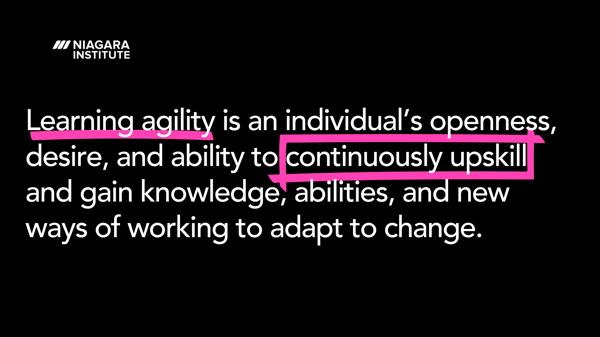6 min read
A Quick Guide to Understanding Self-Leadership
Since 500 BC, there has been an appreciation for the importance and power of self-leadership. In fact, the philosopher Lao-Tzu famously said,...

The world of work is changing, and it is putting increased pressure on employees and the organizations they work for to keep pace. According to IBM’s Future of Work Trends, “The total number of skills required for a single job increases by 10% year over year. At the same time, these skills are other in-kind — 33% of the skills present in an average job posting in 2017 will not be needed by 2021.”
For employees and managers to meet the new demands, continuous learning needs to be a central strategy, and continuous learning starts with learning agility. Let’s begin with a learning agility definition to understand the topic better.
Learning agility is an individual’s openness, desire, and ability to continuously upskill and gain knowledge, abilities, and new ways of working to adapt to change. It is a general curiosity and aspiration to learn and seek new information, perspectives, and experiences.
Learning agility is knowing how to learn. It is the ability to learn from experience, apply it to new situations, and fill in the gaps with new information. It’s the foundation of continuous learning.

While both a growth mindset and learning agility are essential for personal and professional development, they are distinct concepts. A growth mindset is the belief that abilities and intelligence can be developed through dedication and hard work.
On the other hand, learning agility refers to the ability to rapidly learn, adapt, and apply new knowledge and skills in diverse work situations. While a growth mindset provides the foundation for continual improvement, learning agility includes the practical application of agility skills to improve agility at work and navigate complex environments effectively.
Learning agility is composed of several key components that collectively improves one's ability to learn and adapt. These include:
Additionally, self-awareness and a proactive learning agility mindset are crucial, as they drive individuals to seek out new experiences and continually improve their agility skills.
Some people are naturally more learning agile than others. These employees often exhibit a strong learning agility mindset, which allows them to adapt quickly to new situations and challenges. They thrive in environments that require an agile learning process and are often more comfortable with change and uncertainty. However, it's important to note that learning agility in the workplace can be developed and nurtured, even in those who may not initially display a high degree of this skill.
In reading the learning agility definition, it is clear that having a team of individuals with learning agility is the envy of every manager. A dream team where everyone seeks out new information, demonstrates intellectual thirst, is open to new ideas, and takes the initiative to make themselves better.
However, learning agility may not come naturally to many, but it is a skill, and like any skill, it can be developed with knowledge and practice. Here are five practical ways you can build the learning agility of your employees.
In many organizations, the HR and learning teams will have a strategy to promote learning agility and a culture of continuous learning. However, there are additional ways people leaders can facilitate this critical skill within their teams and go even further to develop learning agility if they do not have access to learning professionals within their organizations.
By the time we’re in our careers, we’ve concluded, based on our experiences, what we’re good at. We create beliefs about ourselves when we’re young that stick with us throughout our life. For example, the belief that I’m not good at math. This type of self-opinion can hold people back from pursuing upskilling in a given area as they believe they cannot learn this topic, and it is called a fixed mindset. As a leader, you can encourage your employees to adopt a growth mindset, where they genuinely believe they can learn new things.
In a one-on-one meeting, provide coaching, positive feedback, and praise when you see or hear about an employee learning a new skill or making a new discovery. This little bit of motivation can help spur a growth mindset and the confidence to pursue continuous learning and upskilling.
Exposure to new environments, industries, and people can highlight how little one knows about a topic. Ignorance can be bliss, and exposure to new ideas can build conviction that upskilling is needed.
A few ways to get your employees outside of their comfort zone and be exposed to new environments, people, and ideas could include:
Deflecting, discouraging, or dismissing questions or challenges to the status quo will stifle learning agility. When individuals ask questions, take the perspective they seek to understand, not question your decisions. The same goes when you receive feedback, ideas, or innovations. If you want to encourage those around you to grow and be open to change, you must be yourself.
To encourage and develop learning agility on your team, it's crucial to lead by example. Your employees will be less inclined to embrace learning agility if you’re stuck in your ways, resist change, or are unwilling to admit you do not have all the answers. The people around you pay much attention to what you do and say. Be authentic in admitting what you do not know and sharing how you will go about upskilling.
In addition to embracing and developing learning agility yourself, promote continuous learning by asking powerful and interesting questions, sharing that you do not have the answers, and asking your team to help find them out.
As mentioned previously, learning agility is a skill that can be learned. Attending a program as a team where participants learn about the benefits of learning agility and have the opportunity to practice and hone their skills is a great way to develop this competency. In addition, when everyone on the team has had the chance to learn together, they can encourage each other to apply the skills back on the job and be each other's accountability partners to ensure they’re continually growing and learning.
We believe learning agility and a growth mindset are critical skills workplaces need; that’s why it is one of the four competencies we develop in our Future Skills Program, designed to develop everyone in an organization, from front-line employees to executives.

6 min read
Since 500 BC, there has been an appreciation for the importance and power of self-leadership. In fact, the philosopher Lao-Tzu famously said,...
![[Infographic] Top 10 Leadership Skills for Managers](https://www.niagarainstitute.com/hubfs/Leadership%20Skills%20for%20Managers%20%281%29.png)
5 min read
When you step into a people leadership role, one of your first thoughts is: what do I need to be a great manager? While you’ll need to tap into many...

4 min read
It would be hard to find someone who hasn’t experienced moments at work where they’re overwhelmed by the sheer volume of tasks to complete. It’s the...